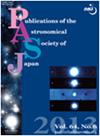Physics of nova outbursts: Theoretical models of classical nova outbursts with optically thick winds on 1.2 M⊙ and 1.3 M⊙ white dwarfs
IF 2.2
4区 物理与天体物理
Q2 ASTRONOMY & ASTROPHYSICS
引用次数: 0
Abstract
We present time-dependent nova outburst models with optically thick winds for 1.2 and 1.35$\, M_{\odot }$ white dwarfs (WDs) with a mass-accretion rate of $5 \times 10^{-9}\, M_{\odot }$ yr−1 and for a 1.3$\, M_{\odot }$ WD with $2 \times 10^{-9}\, M_{\odot }$ yr−1. The X-ray flash occurs 11 d before the optical peak of the 1.2$\, M_{\odot }$ WD and 2.5 d before the peak of the 1.3$\, M_{\odot }$ WD. The wind mass-loss rate of the 1.2$\, M_{\odot }$ WD (1.3$\, M_{\odot }$ WD) reaches a peak of $6.4 \times 10^{-5}\, M_{\odot }$ yr−1 ($7.4 \times 10^{-5}\, M_{\odot }$ yr−1) at the epoch of the maximum photospheric expansion with the lowest photospheric temperature of log Tph (K) = 4.33 (4.35). The nuclear energy generated during the outburst is lost in the form of radiation (61% for the 1.2$\, M_{\odot }$ WD; 47% for the 1.3$\, M_{\odot }$ WD), gravitational energy of ejecta (39%; 52%), and kinetic energy of the wind (0.28%; 0.29%). We found an empirical relation for fast novae between the time to optical maximum from the outburst tpeak and the expansion timescale τexp. With this relation, we are able to predict the time to optical maximum tpeak from the ignition model (at t = 0) without following a time-consuming nova wind evolution.新星爆发物理学:1.2 M⊙和 1.3 M⊙白矮星上带有光学厚风的经典新星爆发理论模型
我们为质量增殖率为 5 \times 10^{-9}\, M_{\odot }$ yr-1 的 1.2 和 1.35$\, M_{\odot }$ 白矮星(WDs)以及质量增殖率为 2 \times 10^{-9}\, M_{\odot }$ yr-1 的 1.3$\, M_{\odot }$ WD 提出了具有光学厚风的随时间变化的新星爆发模型。X 射线闪光发生在 1.2$\, M_{\odot }$ WD 的光学峰值前 11 d 和 1.3$\, M_{\odot }$ WD 的峰值前 2.5 d。1.2$\, M_{\odot }$ WD(1.3$\, M_{\odot }$ WD)的风质量损失率达到了 $6.4 \times 10^{-5}\, M_{\odot }$ yr-1 的峰值($7.4 times 10^{-5}\, M_{\odot }$ yr-1),此时光球层膨胀最大,光球层最低温度为 log Tph (K) = 4.33 (4.35)。爆发期间产生的核能以辐射(1.2$\, M_{\odot }$ WD为61%;1.3$\, M_{\odot }$ WD为47%)、喷出物引力能(39%;52%)和风动能(0.28%;0.29%)的形式损失掉了。我们发现了快速新星从爆发到光学最大值的时间 tpeak 与膨胀时间尺度 τexp 之间的经验关系。有了这一关系,我们就能从点火模型(t = 0)中预测出光学最大值 tpeak 的时间,而无需遵循耗时的新星风演化过程。
本文章由计算机程序翻译,如有差异,请以英文原文为准。
求助全文
约1分钟内获得全文
求助全文
来源期刊

Publications of the Astronomical Society of Japan
地学天文-天文与天体物理
CiteScore
4.10
自引率
13.00%
发文量
98
审稿时长
4-8 weeks
期刊介绍:
Publications of the Astronomical Society of Japan (PASJ) publishes the results of original research in all aspects of astronomy, astrophysics, and fields closely related to them.
 求助内容:
求助内容: 应助结果提醒方式:
应助结果提醒方式:


